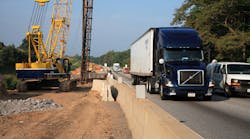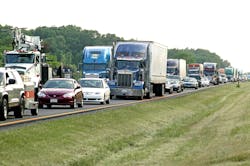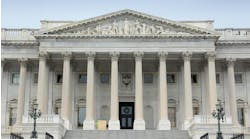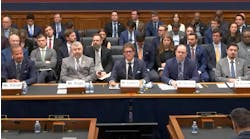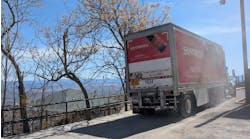A new report issued by the American Transportation Research Institute (ATRI) this week highlights the federal fuel tax as the most “successful model for assessing a road user charge” with one of the lowest collection costs among the various infrastructure funding models examined – including a vehicle miles traveled (VMT) tax and broader use of roadway tolls.
The 63-page report, dubbed A Framework for Infrastructure Funding and authored by Jeffrey Short, ATRI’s senior research associate, also stressed the need not only to raise the federal fuel tax – which is 18.5 cents per gallon for gasoline and 24.5 cents per gallon for diesel; taxes that have remained unchanged for 24 years – but to possibly add in a universal vehicle registration fee to generate additional funds for expanding the nation’s 4 million mile roadway network.
“We inherently believe the ‘best case’ scenario for funding highway infrastructure is the federal fuel tax, but we wanted more data to prove that,” Rebecca Brewster, ATRI’s president, explained to Fleet Owner.
“But not only did we identify the efficiency of the fuel tax, we found it can also create a lot of jobs, particularly highway construction and contractor jobs,” she added. “It’s also a job creator in the sense that by relieving traffic congestion, we get people moving – especially truck drivers – so they are more productive workers.”
That secondary form of “job creation” Brewster cited stems from previous ATRI research that found delays on the more than 220,000 miles of interstate highway that comprise the National Highway System (NHS) equated to more than 996 million hours of lost productivity – equal to 362,243 commercial truck drivers sitting idle for an entire working year.
In terms of those specific job-creating “secondary benefits” from raising the federal fuel tax, ATRI's findings suggest that every U.S. state would experience significant employment gains as a result of a 10 or 20 cent federal fuel tax increase.
In total, states would receive between $15 billion and $30 billion or more annually through a federal fuel tax increase; nearly half a million jobs could be created nationwide with a 20 cent federal fuel tax increase, the report indicated.
Yet the primary need remains the rehabilitation and expansion of the U.S. roadway network, which is in bad and worsening shape, according to ATRI’s report
For example, citing the 2017 Report Card for America’s Infrastructure issued by the American Society of Civil Engineers (ASCE) back in the spring, the nation’s roadways received a “D” as more than 40% of major urban highways are routinely congested at a cost of $160 billion annually in wasted fuel and time, with the U.S. highway system currently underfunded by $836 billion.
ATRI also noted that despite federal, state and local governments expending $235 billion on highways for capital improvements, maintenance and other costs back in 2015: 11% of bridges remain classified as structurally deficient, with 14% classified as functionally obsolete; 16.7% of federal-aid highway pavement is rated as poor; some 6.7 billion hours of delay are experienced by travelers annually.
Along with raising the federal fuel tax, ATRI investigated and indicated a universal vehicle registration fee could not only capture more roadway infrastructure dollars but also function as a way to ensure alternative fueled vehicles – especially all-electric vehicles – pay their “fair share” for highway system upkeep.
“There were approximately 250 million private and commercial cars, trucks and buses registered in the U.S. in 2015 [and], hypothetically, a modest $20 annual federal registration fee on all vehicles, which would be collected through the already implemented state registration process, would generate revenue of $5 billion annually,” ATRI noted in its report. “A more aggressive per-vehicle average fee of $75 would add $18.7 billion to the highway trust fund [HTF] annually.
The report also concluded that the only “meaningful mechanism” to fund a large-scale infrastructure program is through a federal fuel tax increase as the “inefficiency” of other mechanisms, including VMT fees and tolls, would fall far short of the needed revenue stream and place “undue hardship” on system users.
ATRI noted that that the cost for collecting federal taxes is just 0.2% of the revenue collected. By translation, in 2015, it cost about $69 million to collect $34.5 billion in revenue. “The key to this efficiency is the limited number of excise tax transactions; there are only 1,304 collection points made up mostly of major fuel distributors who pay the tax directly to the U.S. Treasury Department,” the group said in its report.
By contrast, tolls – used on only 5,051 miles of U.S. highways currently – require more resources to collect, often requiring between 12% and 25% of the revenue collected. ATRI also cited previous research that found, in some cases, up to 30.3% of toll revenue is spent on just collecting tolls.
Where a potential VMT fee is concerned, ATRI used what it called a “hypothetical and very conservative cost” of $50 annually per vehicle to install and maintain the technology, track, collect and enforce a national VMT fee – estimating that would require a total collection cost in the range of $12.5 billion annually.
To collect that effectively, ATRI cited the model used by the Internal Revenue Service (IRS). In 2015, 79,890 IRS employees, using a budget of $11.4 billion, processed 240 million tax returns. Thus, at the federal level, deploying, monitoring, collecting, and enforcing compliance for a VMT tax on a similar number of entities -- some 250 million registered vehicles in the U.S. – would require “a similar, if not more technologically complex” government program.
Additionally, ATRI argued that mileage tax evasion would likely skyrocket under a program that can't "see" non-paying users.
At the end of the day, Brewster stressed to Fleet Owner, the critical issue is generating more funds for roadway infrastructure in order to keep up with growing economic activity – especially in the realm of e-commerce.
E-commerce activity has thrust a greater proportion of supply chain logistics and “last-mile” deliveries into the midst of dense urban regions, ATRI noted in its report, with smaller yet more numerous warehouses being built in urban population centers.
The net effect is that these distribution facilities are both closer to large population centers to meet consumer needs for high-speed, low-cost shipping – while at the same time they are at the “epicenter” of traffic snarls and freight bottlenecks, the group said.
“Taken together, not only is the volume of e-commerce logistics activity growing rapidly, it is increasing the most in urban areas where transportation infrastructure is severely strained,” Brewster noted.
Going forward, ATRI’s report stated “it is a certainty” that that the challenges associated with short-term retail shipping will be increasingly difficult for e-commerce players, and the cost to ship goods will increase with travel delays.
“Given the importance of low-cost and expeditious shipping to the e-commerce business model, it is clear that deficient transportation infrastructure is one of the most significant obstacles facing the industry today,” ATRI concluded.
